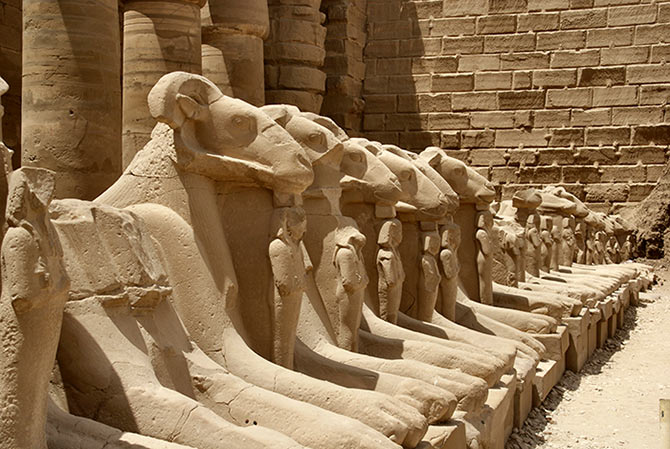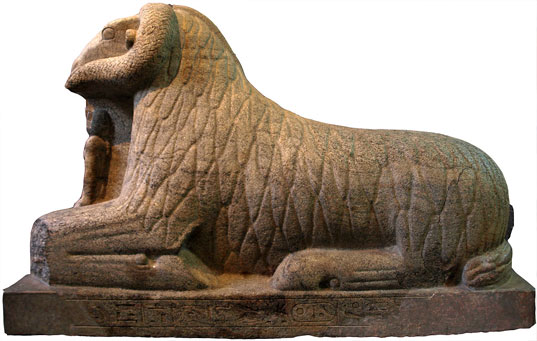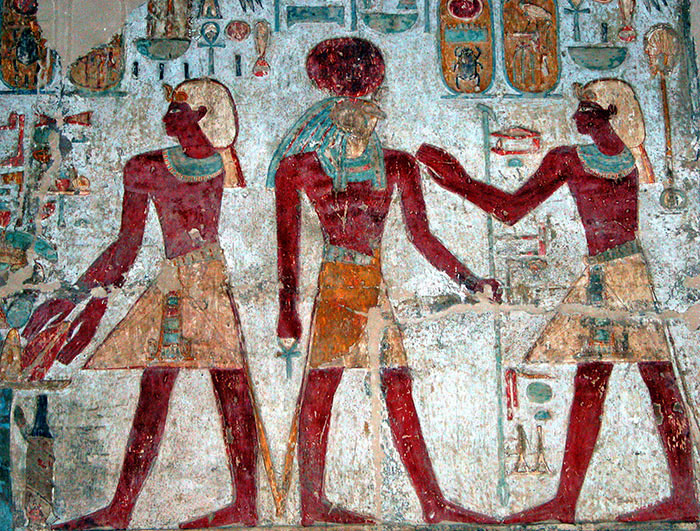Cult
Worship of Amun was widespread and the pharaohs’ awarded the cult with land a percentage of the booty from conquests. One of the important positions in the cult was the “god’s wife of Amun” and the queen or queen-mother often fimagecentered this role. These women gained power and depictions show them making offerings to gods.
Two festivals at Thebes involved the images of Amun and other deities traveling to other places:
- During the Beautiful Feast of the Valley, images of the Thebean Triad were taken out of Karnak. They traveled on a boat, across the Nile, to visit the mortuary temples on the west bank.
- At the celebration of the Opet Festival, Amun traveled from the Great Temple at Karnak to the temple at Luxor. This festival celebrated the sacred marriage between the god (Pharaoh) and the god’s wife (the queen).
Temples
Temples dedicated to Amun were built throughout Egypt and Ramses II built or rebuilt several of them. Three of these temples are those at Deir el-Medina, Luxor and Karnak:
- Deir el-Medina is located on the western bank of the Nile across from Thebes and near the Valley of the Kings. Ramses II built this temple and two dedicated to the other members of the Thebean Triad.
- Amun’s temple at Luxor was first built around 1500 BC and has been an active religious site up to the present day. People worshiped a unique version of Amun, named Amenemope (Amun of Opet). Two names for the Luxor Temple are the “Place of Seclusion” or the Southern Opet. This temple was in the heart of ancient Thebes and a processional road connected it to Karnak.
- The temple complex at Karnak is the largest temple complex built by humans and the Great Temple of Amun is its crown jewel. Generations of pharaoh’s added to or rebuilt sections of this temple. Criosphinxes (sphinxes with ram heads) line one of the processional ways. Several courts, obelisks, and pylons, carved with hieroglyphics, are part of this temple. Several temples are part of this complex including one dedicated to Aten. Akhenaten built it during the first five years of his reign, before he moved the capital to Amarna.

© Nick Dawson – Criosphinx statues at the temple of Amun at Karnak
Symbols
Egyptian artwork associates several symbols with Amun:
- The ram (criosphinx: a sphinx with a ram head).
- The goose
- At times, Amun’s frescos show him as an ape or a lion.

Depictions
Images and statues of Amun usually show him as a man with a blue or black skin.
- He wears a double-plumed headdress and the plumes have alternating colors of either red and green or red and blue.
- Amun wears several pieces of jewelry including a broad collar or necklace, bracelets and armlets.
- His clothing is either a kilt or a tunic with decorated shoulder straps.
- Amun holds an ankh in his right hand and a scepter in his left hand and sometimes a bull’s tail hangs from his tunic.
Amun is also depicted with various animal heads. On occasion, he has a hawk’s head with a sun disc encircled by a serpent on top. Other depictions show Amun with a ram’s head.
Depictions of Amun with his wife Amunet show him with:
- An uraeus (upright form of an Egyptian cobra) head and Amunet with a cat head,
- or Amun with a frog head and Amunet with an uraeus head.
 © Dennis Jarvis – Amun-Ra (center) in the temple of Amada
© Dennis Jarvis – Amun-Ra (center) in the temple of Amada
Legends
Amun was a creator god and a force that created life. Instead of featuring in a story myth, many writings about him tell how he helped people gain a victory or solve a problem. Other inscriptions tell of oracles Amun gave to petitioners. His statue would move (hidden priests manipulated it) to answer a question.









































